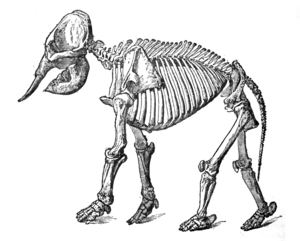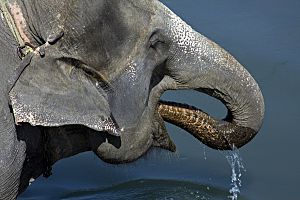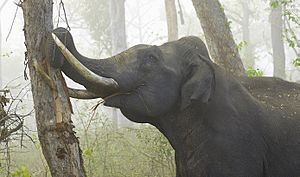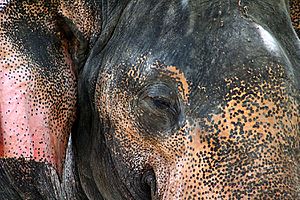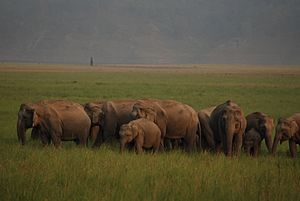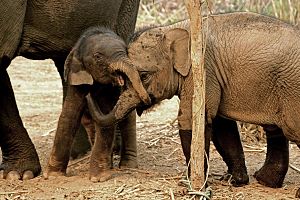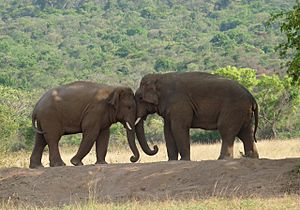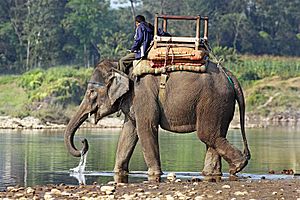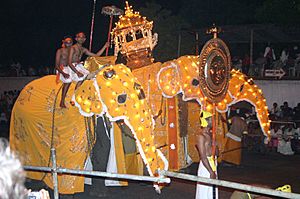Asian elephant facts for kids
Quick facts for kids Asian Elephant |
|
|---|---|
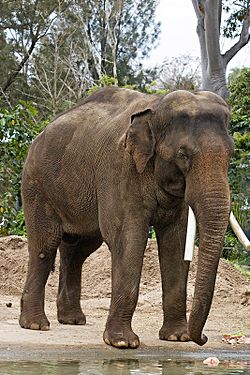 |
|
| Asian elephant | |
| Conservation status | |
| Scientific classification | |
| Kingdom: | |
| Phylum: | |
| Subphylum: | |
| Superclass: | |
| Class: | |
| Subclass: | |
| Superorder: | |
| Order: | |
| Superfamily: |
Elephantoidea
|
| Family: | |
| Genus: |
Elephas
|
| Species: |
E. maximus
|
| Binomial name | |
| Elephas maximus Linnaeus, 1758
|
|
 |
|
| Asian Elephant range | |
The Asian Elephant (Elephas Maximus) is a large animal that lives in Asia. These elephants are often easier to train than the bigger African elephants. For hundreds of years, people have used them as working animals.
Contents
Discover the Asian Elephant
Asian elephants are generally smaller than the African bush elephant. They have smaller ears compared to their African relatives. Their feet also have more nail-like structures. Each front foot has five nails, and each back foot has four.
How Big Are They?
Male Asian elephants are usually about 2.75 meters (9 feet) tall at the shoulder. They can weigh around 4 tons (8,800 pounds). Females are a bit smaller. They stand about 2.4 meters (7.9 feet) tall and weigh about 2.7 tons (6,000 pounds).
The biggest male elephant ever recorded was huge. It weighed 7 tons (15,400 pounds). It was 3.43 meters (11.25 feet) tall at the shoulder. This giant elephant was found in India in 1924.
The Amazing Trunk
An elephant's trunk is very special. It is a long nose and upper lip combined. The nostrils are at the very tip. The trunk has a small, finger-like part at its end. This amazing tool has as many as 60,000 muscles!
The trunk is super sensitive and has many uses. Elephants use it to breathe, drink water, and find food. They also use it for touching, dusting, and making sounds. It helps them communicate, wash themselves, and even fight. An elephant's trunk can hold about four liters (1 gallon) of water.
What About Tusks?
Tusks are long, pointed teeth. Elephants use them to dig for water, salt, and rocks. They also use tusks to peel bark off trees and pull up roots. Tusks can help them move fallen trees and branches. They are also used for showing off, marking trees, and for defense. Some elephants prefer to use their right tusk, while others prefer their left.
Female Asian elephants usually do not have tusks. If they do, these are very small. They are called "tushes" and are only seen when the elephant opens its mouth.
Elephant Skin
Asian elephants usually have grey skin. This color can be hidden by soil from dusting and wallowing. Their skin is wrinkled and can move. It is smoother than the skin of African elephants. Sometimes, their skin can have lighter patches on the trunk, ears, or neck.
An elephant's skin is very thick. It is about 18 millimeters (0.7 inches) thick on average. On their back, it can be 30 millimeters (1.2 inches) thick. This thick skin protects them from bites, bumps, and bad weather. Elephants can handle cold better than very hot weather.
Elephant Communication and Smarts
Asian elephants make three main sounds: growls, squeaks, and snorts. Growls are for talking over short distances. For longer distances, growls become roars. Some growls are very low-frequency, called infrasonic sounds. Squeaks can be chirps or trumpets. Chirping means they are nervous or in conflict. Trumpets are loud, long squeaks. Elephants can hear very quiet sounds.
How Smart Are They?
Asian elephants are very intelligent animals. They are also self-aware, meaning they know they exist as individuals. They show many different behaviors. These include showing grief, learning new things, and helping care for young ones. They also mimic others, play, and show kindness. Elephants use tools, show compassion, and work together. They have good memory and use a form of language.
Some people say elephants move to higher ground during natural disasters. This includes events like tsunamis and earthquakes. However, scientists have not been able to study this closely. It is hard to predict these events.
Where Do Asian Elephants Live?
Asian elephants live in many different places. They can be found in grasslands and various types of forests. These include tropical evergreen forests, semi-evergreen forests, and moist or dry deciduous forests. They also live in dry thorn forests, farmed areas, and scrublands.
In China, Asian elephants only live in the southern part of Yunnan province. In Bangladesh, some small groups live in the south-east Chittagong Hills.
Scientists recognize three main types of Asian elephants:
- The Sri Lankan elephant lives in Sri Lanka.
- The Indian elephant lives in mainland Asia. This includes countries like Bangladesh, Bhutan, Cambodia, China, India, Laos, Malay Peninsula, Myanmar, Nepal, Thailand, and Vietnam.
- The Sumatran elephant lives on the island of Sumatra.
The Borneo elephant lives in the northern parts of Borneo.
Elephant Life and Habits
Elephants are most active during dawn and dusk. They are very large plant-eaters. They can eat up to 150 kilograms (330 pounds) of plants every day! They eat both grass and leaves from trees and bushes. They have been seen eating 112 different types of plants. They especially like plants from the mallow, pea, palm, sedge, and grass families.
During the dry season, they eat more bark from trees. They need to drink water at least once a day. So, they always stay close to a fresh water source. They need 80–200 liters (21–53 gallons) of water daily. They use even more water for bathing. Sometimes, they dig in the soil to find clay or minerals to eat.
Female elephants and their young calves often travel together in groups. However, male elephants leave their mothers when they become teenagers. Male elephants might live alone or form temporary groups with other males. Elephant social groups are usually not as strong as those of African elephants.
Elephants can hear very quiet sounds. They use low-frequency sounds, called infrasound, to talk to each other. It is rare for tigers to hunt Asian elephants. But it can happen, and not just to small calves.
Elephant Reproduction and Life Cycle
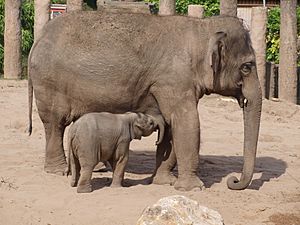
Male elephants between 10 and 20 years old go through a special period called "musth" each year. During musth, their testosterone levels are much higher. This makes them very aggressive. They will fight other males to mate with females.
A female elephant is pregnant for 18–22 months. She usually gives birth to one calf, but sometimes to twins. The baby is fully formed by the 19th month. But it stays in the womb longer to grow bigger. This helps it reach its mother to feed after birth. A newborn calf weighs about 100 kilograms (220 pounds). It drinks its mother's milk for up to three years.
After a female gives birth, she usually waits until her first calf stops drinking milk before having another baby. This means there is usually a four to five year gap between births. Female elephants stay with their herd for life. But male elephants leave the herd when they grow up.
Asian elephants become adults at about 17 years old. In the wild, elephants live for about 60 years. In zoos, they can live up to 80 years.
Elephants and Humans
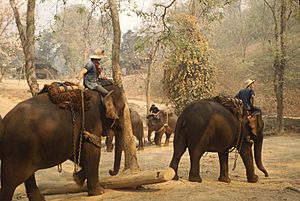
Most of the time, Asian elephants are shy. They would rather run away from danger than attack. However, some male elephants, called "rogues," can be an exception. They might attack people without being provoked. Sometimes, rogue elephants block roads, making it unsafe for travelers.
Female elephants with calves are always dangerous to approach. If an Asian elephant charges, it curls its trunk tightly. It attacks by stepping on its victim with its feet or knees. If it's a male, it might pin the victim to the ground with its tusks. During musth, male elephants are very dangerous to both humans and other animals. Trained elephants are kept securely tied up when they show signs of musth.
How Elephants Became Domesticated
People started taming Asian elephants a very long time ago. The first records are from the Harappan times. Over time, elephants became very important. They were used in wars, as a sign of wealth, and as animals that carried heavy things. They also served as high platforms for hunting.
Elephants were caught from the wild and trained by humans. Their ability to follow instructions made them very useful for carrying heavy objects. They were especially used for moving timber in jungle areas. Besides work, they were used in battles, ceremonies, and for rides. Hunters used them to travel over difficult land. Today, they are used for safaris in the same way.
Threats to Asian Elephants
The biggest danger to Asian elephants today is the loss of their natural homes. This leads to more conflicts between humans and elephants. Elephants are also poached (illegally hunted) for their ivory tusks. They are also hunted for their meat and leather.
Protecting Asian Elephants
The Asian elephant is listed under CITES Appendix I. This means that trade in elephants must be carefully controlled. This helps make sure that using them does not threaten their survival.
World Elephant Day has been celebrated every year on August 12 since 2012. Events are held to share information and get people involved in helping Asian elephants. August is also known as Asian Elephant Awareness Month in many zoos and conservation groups in the United States.
In China, Asian elephants have the highest level of protection. In Thailand, places like Salak Pra Wildlife Sanctuary and Tham Than Lot National Park protect about 250–300 elephants.
Images for kids
-
Prime elephant habitat cleared for jhum—a type of shifting cultivation practiced in Arunachal Pradesh
See also
 In Spanish: Elefante asiático para niños
In Spanish: Elefante asiático para niños



